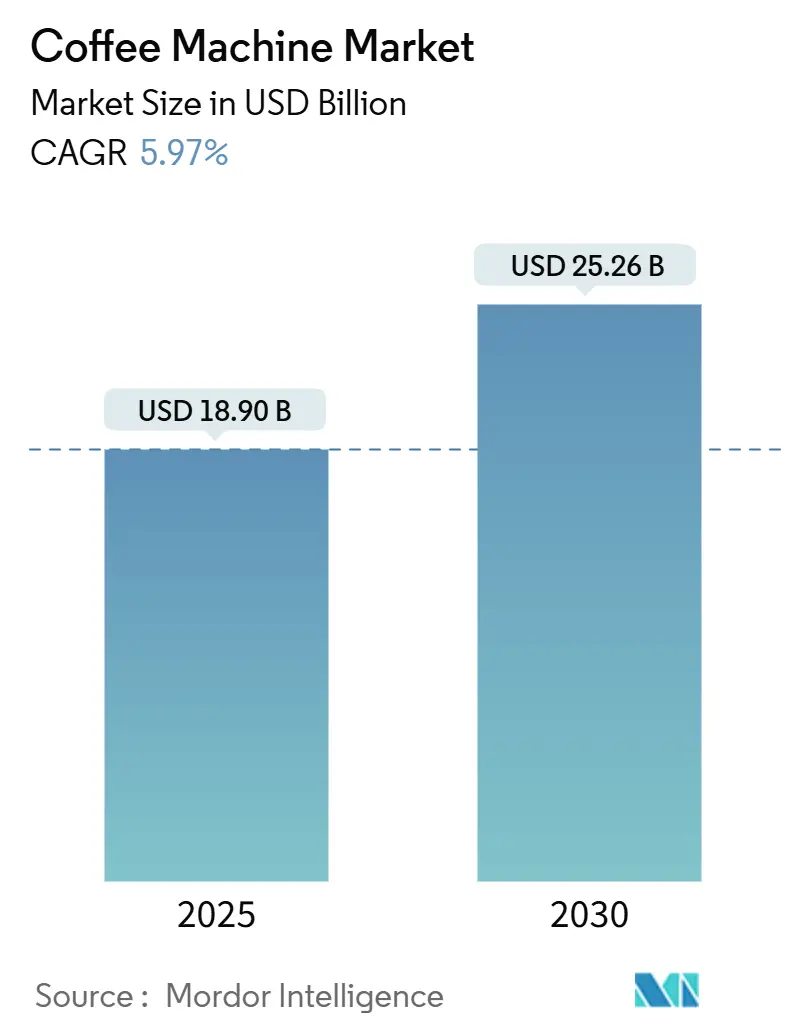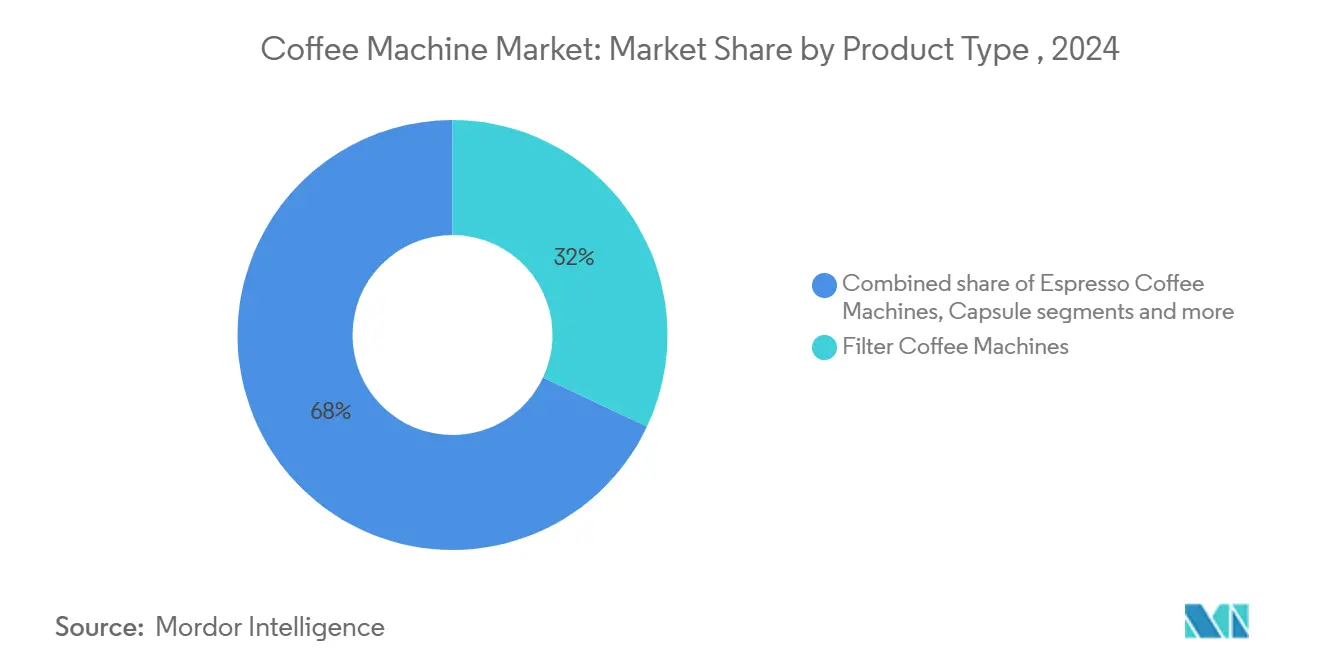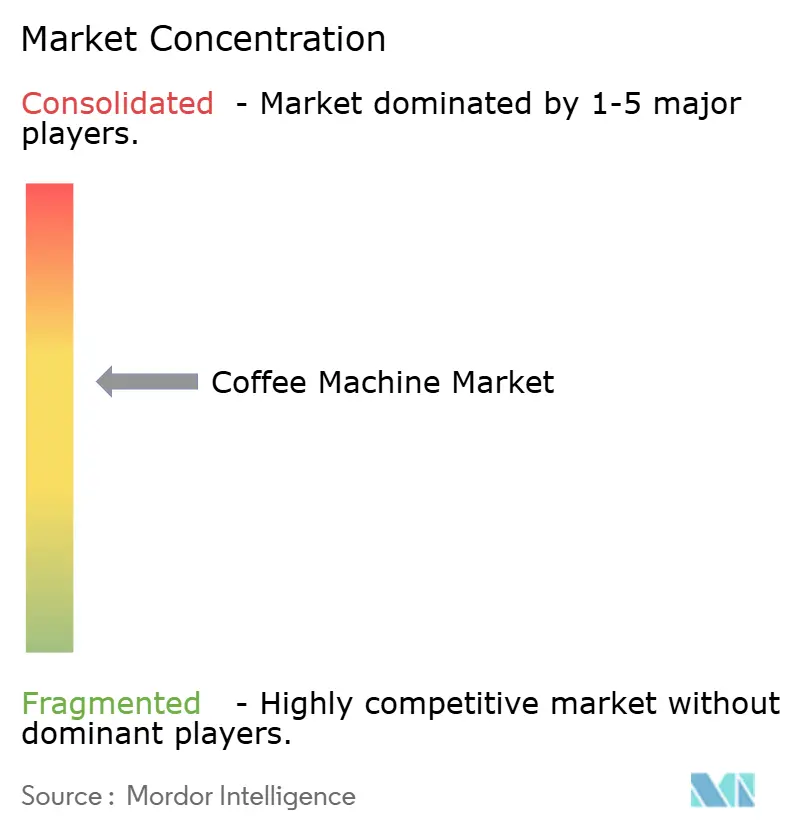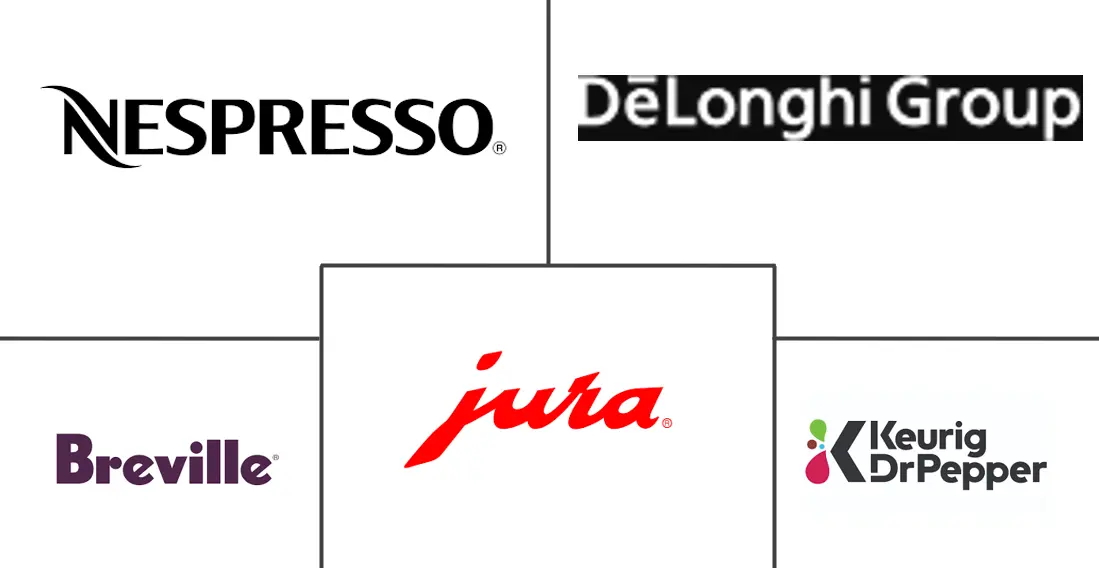Coffee Machine Market Size and Share

Coffee Machine Market Analysis by Mordor Intelligence
The coffee machine market is valued at USD 18.90 billion in 2025 and is projected to reach USD 25.26 billion by 2030, expanding at a 5.97% CAGR. Demand is rising as households replicate café experiences while managing the escalating cost of out-of-home beverages. Europe remains the largest revenue generator, backed by entrenched espresso culture and higher discretionary income, whereas Asia-Pacific posts the fastest gains as urban consumers move rapidly from instant coffee to premium appliances. Filter brewers still anchor volumes, yet capsule systems and fully automatic models capture faster upgrades as convenience outweighs higher per-cup costs. Competitive intensity is increasing as technology-oriented brands leverage smart features, ecosystem partnerships, and sustainability credentials to erode share held by entrenched incumbents.
Key Report Takeaways
- By product type, filter brewers held 32% of coffee machine market share in 2024, while capsule/pod machines are forecast to grow at a 7.5% CAGR through 2030.
- By automation level, fully automatic and super-automatic units accounted for 77% of the coffee machine market size in 2024 and are set to expand at a 6.4% CAGR to 2030.
- By end user, the residential segment captured 70% of the coffee machine market in 2024 and is projected to register a 6.2% CAGR.
- By distribution channel, B2C outlets represented 69% of the coffee machine market in 2024, with online-led B2C revenue poised to rise at a 6.8% CAGR.
- By geography, Europe dominated with 41% revenue share in 2024, whereas Asia-Pacific is tracking a 7.7% CAGR through 2030.
Global Coffee Machine Market Trends and Insights
Drivers Impact Analysis
| Driver | ( ~ ) % Impact on CAGR Forecast | Geographic Relevance | Impact Timeline |
|---|---|---|---|
| Rising coffee consumption worldwide | +1.2% | Global, strongest in Asia-Pacific and emerging markets | Medium term (2-4 years) |
| Growth of at-home coffee culture | +1.8% | North America and Europe core, expanding to urban Asia-Pacific | Short term (≤ 2 years) |
| Expansion of specialty coffee chains and cafés | +0.9% | Global, concentrated in large cities | Long term (≥ 4 years) |
| Technological advancements in smart coffee machines | +1.4% | Early adoption in North America and Europe, Asia-Pacific following | Medium term (2-4 years) |
| Demand for convenience and single-serve solutions | +1.1% | Global, strongest in developed markets | Short term (≤ 2 years) |
| Corporate Decarbonisation Targets Boosting Energy-Efficient Brewers | +0.7% | Europe & North America leading, expanding to multinational corporations globally | Long term (≥ 4 years) |
| Source: Mordor Intelligence | |||
Rising Coffee Consumption Worldwide
A growing consumer preference for specialty and premium coffee is driving the coffee machine market. Global coffee consumption grew 2.2% year-over-year in 2024, handily outpacing growth in tea and carbonated soft drinks, according to the International Coffee Organization. Momentum is particularly strong in China. Over the past decade, China's coffee consumption skyrocketed by nearly 150%, with projections indicating a reach of 6.3 million 60-kilogram bags in the 2024/25 period [1]U.S. Department of Agriculture, Foreign Agricultural Service, “Coffee: World Markets and Trade,”. In 2024, according to the National Coffee Association (NCA), daily coffee consumption among American adults has surged by 37% since 2004, reaching a two-decade peak, bolstering sales of drip, pod, and espresso models that meet diverging taste preferences [2]National Coffee Association USA, “Daily Coffee Consumption at 20-Year High, Up Nearly 40,” www.ncausa.org. Emerging markets such as Indonesia and Vietnam add incremental volume as rising middle-class households shift from soluble coffee to fresh-brew methods that require appliances.
Growth of At-Home Coffee Culture
Sixty-five percent of Americans now drink coffee daily, and 54% brew their first cup within an hour of waking, reinforcing the central role of home equipment in daily routines [3]U.S. Department of Agriculture, Foreign Agricultural Service, “Coffee: World Markets and Trade,”. Similar habits prevail in Europe, where 80% of UK households keep instant coffee yet increasingly supplement with espresso-based drinks prepared on fully automatic machines. Social media has amplified brewing rituals. Accessory sales—grinders, scales, and tamper kits—grew significantly in 2024, indicating broader ecosystem opportunities for manufacturers.
Expansion of Specialty Coffee Chains and Cafés
China’s branded café count surpassed 50,000 outlets in 2024, a 58% jump largely driven by Luckin Coffee and Cotti Coffee price promotions that acclimate consumers to specialty beverages [4]National Coffee Association USA, “Atlas of American Coffee Consumption 2025,” ncausa.org. International chains also expand: Starbucks added 700 stores in China and 100 stores in India during 2024, further normalizing espresso-based drinks in Asia. Coffee shop density in South Korea reached one outlet per 509 residents, the world’s highest, exposing consumers to hand-poured V60 and cold-brew towers that inspire home experimentation. Specialty chains educate patrons on origin, roast profile, and brewing variables, stimulating demand for bean-to-cup and manual pour-over devices capable of reproducing café flavors at home. Urban Latin America is following similar trajectories; Mexico City logged a 14% increase in specialty cafés in 2024, translating into rising imports of Italian pump-driven machines.
Technological Advancements in Smart Coffee Machines
As the market embraces smart living, Wi-Fi-connected coffee machines have made their debut. Bluetooth and Wi-Fi-connected features are becoming popular, allowing users to control their coffee machines via smartphones from anywhere within the home's connectivity range. Connected brewers now integrate with Amazon Alexa, Google Home, and proprietary IoT hubs, letting users start a brew cycle from bed or receive maintenance prompts on mobile apps. Bosch’s 800-Series espresso machines link to Home Connect for remote recipe selection and consumable tracking, while JURA models use RFID filters to detect hardness and adjust settings automatically. Manufacturers embed machine-learning algorithms that store user preferences, refine grind coarseness, and deliver tailored beverages without additional input, enhancing loyalty for premium models. Electrolux is piloting blockchain-logged brew data to verify bean provenance, thereby merging traceability with smart-home convenience.
Restraints Impact Analysis
| Restraint | ( ~ ) % Impact on CAGR Forecast | Geographic Relevance | Impact Timeline |
|---|---|---|---|
| High cost of premium machines and accessories | -0.8% | Global, strongest in price-sensitive emerging markets | Short term (≤ 2 years) |
| Environmental concerns around pod waste | -0.6% | Europe and North America lead, expanding globally | Medium term (2-4 years) |
| Saturation in developed markets | -0.4% | North America and Western Europe primarily | Long term (≥ 4 years) |
| Cybersecurity risks for connected appliances | -0.3% | Global, concentrated in tech-forward markets | Medium term (2-4 years) |
| Source: Mordor Intelligence | |||
High Cost of Premium Machines and Accessories
While budget-friendly drip coffee makers and single-serve machines lead the lower-price segment, premium pricing characterizes high-end espresso machines and smart coffee makers. These sophisticated models, boasting features like precision temperature control, integrated grinders, automatic milk frothing, and AI-driven customization, often command a higher price range. Price tags for fully automatic models pose a hurdle in price-sensitive segments, especially where per-capita income lags OECD averages. Total cost of ownership magnifies the hit: water filters, descaling solutions, and proprietary pods can surpass the original purchase price over five years. Brands respond with step-down variants—fewer grinder settings, plastic housing instead of stainless steel—to balance affordability and performance. Deferred-payment schemes and machine-plus-bean subscriptions, pioneered by Breville’s beanz™ platform, help diffuse upfront barriers. Nonetheless, cost sensitivity slows penetration in emerging markets where premium appliances compete against low-priced instant-coffee habits.
Environmental Concerns Around Pod Waste
Plastic components in many coffee machines exacerbate pollution and microplastic issues. A significant portion of these pods lacks biodegradability, resulting in overflowing landfills and enduring environmental repercussions. Annually, the world grapples with a coffee capsule waste footprint nearing 576,000 metric tons. The EU Deforestation-free Regulation, effective December 2025, requires coffee traders to verify zero-deforestation supply, adding documentation burdens and possible fines for non-compliance[5]World Coffee Portal, “China Becomes the World’s Largest Branded Coffee Shop Market,” worldcoffeeportal.com. Brands developing robust take-back schemes and bio-based materials mitigate environmental headwinds while retaining single-serve convenience.
Segment Analysis
By Product Type: Filter Dominance Meets Capsule Momentum
Filter coffee machines accounted for 32% of the coffee machine market share in 2024. Their ability to produce several cups at once, accept any ground coffee, and offer competitive per-cup costs sustains volume leadership in mature regions. Capsule machines, however, are projected to add the largest incremental revenue as the segment grows 7.5% annually. Convenience, portion control, and flavor consistency attract busy households, while recent launches of biodegradable capsules address rising environmental scrutiny.
Espresso and bean-to-cup machines cater to quality seekers who value pressure brewing and fresh grinding. Although niche in unit terms, these categories lift average selling prices and underpin premium brand margins. Manual devices such as Moka pots and French presses maintain cultural relevance and appeal to purists but contribute little to aggregate revenue growth. Product diversification across these tiers allows brands to meet divergent consumer aspirations within the broader coffee machine market.

Note: Segment shares of all individual segments available upon report purchase
By Automation Level: Super-Automatic Machines Extend Lead
Fully automatic and super-automatic units captured 77% of the coffee machine market size in 2024, outpacing semi-automatic models through compelling convenience. A forecast 6.4% CAGR rests on user demand for one-touch beverages, self-cleaning cycles, and app-based customization. Manufacturers refine grinders, milk systems, and extraction algorithms to enhance in-cup quality while simplifying upkeep.
Semi-automatic machines hold a loyal base of enthusiasts who prefer hands-on control and upgrade paths to professional-grade accessories. Their slower growth reflects a smaller addressable audience and learning curve constraints. Innovation now concentrates on bridging the gap: mid-tier models add assisted tamping and pressure profiling to blend artistry with ease. Despite different user profiles, both subcategories rely on technological updates to sustain relevance in the expanding coffee machine market.
By End User: Residential Demand Underpins Sales
Residential buyers generated 70% of revenue in 2024 and will expand at a 6.2% CAGR as hybrid work patterns keep brewing occasions inside the home. The coffee machine market benefits from repeat purchases when first-time drip users transition to capsule or super-automatic platforms. Brands leverage lifestyle advertising and influencer content to emphasize café-quality results and cost savings versus daily takeaway drinks.
Commercial installations remain vital for offices, restaurants, and hotels seeking to elevate customer experience. Specialized models promise higher throughput, telemetry for preventive maintenance, and energy efficiency certifications that reduce lifetime operating expenses. While lower in unit volume, commercial buyers drive demand for rugged components and service contracts that sustain aftermarket revenue. The residential-commercial mix, therefore, balances high-margin consumer upgrades with steady institutional refresh cycles.
By Distribution Channel: Digital B2C Models Gain Traction
B2C outlets—e-commerce marketplaces, brand webshops, and omnichannel retailers—held 69% of 2024 revenue and are projected to rise at a 6.8% CAGR. Consumers increasingly research specifications and user reviews online before purchase, favoring merchants that offer speedy delivery, installation support, and bundled accessories. Direct-to-consumer programs enable manufacturers to capture data, cross-sell beans, and launch subscription services, raising customer lifetime value inside the coffee machine market.
B2B channels focus on volume orders and bespoke features for corporate and hospitality settings. Procurement teams prioritize reliability, water filtration compatibility, and service response times. Manufacturers cultivate these accounts through dedicated sales teams and leasing arrangements. Despite slower growth, B2B sales protect volume during consumer spending downturns and create showcase environments that influence residential buyers.

Note: Segment shares of all individual segments available upon report purchase
Geography Analysis
Europe delivered 41% of 2024 revenue. Germany imported 986 thousand tonnes of green coffee in 2023, primarily from Brazil and Vietnam, underpinning demand for commercial and residential brewers. Specialty consumption across Western Europe is expanding significantly, prompting replacement cycles toward energy-efficient machines with grind-by-weight capability. Scandinavian markets, led by Sweden and Norway, show the highest ratio of automatic machines per household, reflecting consumer willingness to pay for convenience. Implementation of the EU Deforestation-free Regulation favors brands equipped with traceability tools and recyclable materials.
Asia-Pacific posts the fastest 7.7% CAGR. South Korea’s preference for cold brew drives demand for machines with dual-temperature spouts and nitro-infusion modules. India recorded a double-digit rise in online searches for espresso machines in 2024, signaling untapped potential as urban millennials trade chai stalls for craft cafés. Japan’s aging population favors compact pod units with automatic descaling cycles, illustrating demographic nuances within Asia-Pacific.
North America remains a mature yet sizeable arena. The United States logged the highest unit sales in 2024; growth came primarily from premium upgrades rather than first-time buyers. Energy-Star-certified commercial brewers save operators 27% in electricity costs, a selling point for office and hospitality accounts. Canada’s specialty-roaster boom fosters demand for grinders and manual methods, complementing automatic machine sales as consumers explore bean variety. Latin America, the Middle East, and Africa contribute modest volumes but display high elasticity. The MENA coffee market is expected to grow significantly as café culture intertwines with social rituals.

Competitive Landscape
Competition is moderate, with the top five brands estimated to hold more than half of the combined share. Pod-centric ecosystems from Keurig Dr Pepper and Nestlé Nespresso dominate consumables, yet both face single-serve sustainability pushback. Keurig’s flat K-Cup shipments contrast with Breville’s record USD 1.5 billion FY 2024 revenue, driven by premium semi-automatic models. Bosch, JURA, and De’Longhi double down on connectivity and AI-assisted brewing, aiming to differentiate through personalized flavor profiling.
Strategic moves illustrate repositioning. De’Longhi revamped its professional division governance to widen commercial exposure, pairing traditional Italian design with telemetry that lowers downtime. Private-label machines from big-box retailers undercut entry-level prices, pushing incumbents to prove superior value through longer warranties and customer support.
Sustainability and regulation reshape brand positioning. ISO standards covering moisture content (ISO 1446) and caffeine quantification (ISO 4052) favor established manufacturers capable of certified laboratory testing. Brands pioneering recyclable pods or biodegradable internal components receive favorable coverage in European mainstream media, enhancing premium perception and willingness to pay. Meanwhile, direct-to-consumer roaster collaborations allow machine makers to embed ongoing bean subscriptions, converting one-off sales into long-term revenue streams.
Coffee Machine Industry Leaders
-
De'Longhi Group
-
Keurig Dr. Pepper Inc.
-
Nestlé Nespresso S.A.
-
Breville Group
-
JURA Elektroapparate
- *Disclaimer: Major Players sorted in no particular order

Recent Industry Developments
- April 2025: Gaggenau introduced a premium coffee-machine range featuring smart-home integration under BSH’s luxury strategy.
- April 2025: Nestlé posted CHF 22.6 billion (USD 24.6 billion) Q1 2025 revenue, citing coffee and confectionery as primary growth drivers.
- May 2024: Bosch launched 300- and 800-Series fully automatic espresso machines, priced USD 699–2,299, featuring Home Connect capability.
- January 2024: JURA broke ground on a new U.S. service center to support rising automatic-machine demand.
Research Methodology Framework and Report Scope
Market Definitions and Key Coverage
Our study defines the coffee-machine market as factory-built equipment that brews coffee by drip, espresso, pod, capsule, or bean-to-cup processes for home as well as foodservice settings, and whose value is captured at manufacturer selling price. Equipment dedicated solely to industrial roasting, grinders sold separately, and vending kiosks are outside scope.
Scope Exclusion: Accessories, stand-alone grinders, and refurbished units are not counted.
Segmentation Overview
- By Product Type
- Espresso Coffee Machines
- Filter/Drip Coffee Machine
- Capsule/Pod Coffee Machine
- Bean-to-Cup Coffee Machines
- Other Product Types (Moka Pot, French Press, etc.)
- By Automation Level
- Semi-Automatic
- Fully Automatic / Super-Automatic
- By End User
- Residential
- Commercial
- By Distribution Channel
- B2C Channels
- Multi-Brand Stores
- Exclusive Brand Outlets
- Online
- Other Distribution Channels
- B2B Channel (directly from the manufacturers)
- B2C Channels
- By Geography
- North America
- Canada
- United States
- Mexico
- South America
- Brazil
- Peru
- Chile
- Argentina
- Rest of South America
- Asia-Pacific
- India
- China
- Japan
- Australia
- South Korea
- South East Asia (Singapore, Malaysia, Thailand, Indonesia, Vietnam, and Philippines)
- Rest of Asia Pacific
- Europe
- United Kingdom
- Germany
- France
- Spain
- Italy
- BENELUX (Belgium, Netherlands, and Luxembourg)
- NORDICS (Denmark, Finland, Iceland, Norway, and Sweden)
- Rest of Europe
- Middle East And Africa
- United Arab of Emirates
- Saudi Arabia
- South Africa
- Nigeria
- Rest of Middle East And Africa
- North America
Detailed Research Methodology and Data Validation
Primary Research
We interviewed distributors in Europe, café chain procurement heads in North America, and appliance retailers across Asia-Pacific. Their insights on average selling prices, automation preferences, and replacement cycles helped us validate shipment volumes estimated from secondary data and fine-tune regional demand assumptions.
Desk Research
Analysts began with open data from sources such as UN Comtrade import codes for household and commercial coffee brewers, production output tables from the International Coffee Organization, energy-efficiency registries (ENERGY STAR and EU Ecodesign), customs tariffs published by USITC, and sales volumes released by the National Coffee Association. These were matched with company 10-Ks and investor decks to gauge revenue splits by product format. Subscription databases, D&B Hoovers for company financials, Dow Jones Factiva for shipment news, and Questel for patent trends, helped benchmark competitive intensity and innovation cycles. The above sources illustrate, not exhaust, the wider set screened by Mordor analysts for data collection, validation, and clarification.
Market-Sizing & Forecasting
A top-down and bottom-up blend starts with global production and trade statistics, which are then adjusted for in-channel inventories and refurbished flows before being further filtered through household penetration rates, café counts, average selling price progression, disposable-income growth, regulatory energy standards, and pod system replacement intervals. Select supplier roll-ups and sampled ASP × unit checks confirm totals. Forecasts apply multivariate regression with GDP per capita, urbanization, and café density as leading indicators, while scenario analysis captures possible shifts in at-home consumption post-pandemic.
Data Validation & Update Cycle
Model outputs pass three analyst reviews, anomaly checks against external time series, and variance reconciliation with expert feedback. Our team refreshes every twelve months, triggering interim updates when material events, trade tariffs, regulation changes, and large mergers occur, so clients receive the latest vetted baseline.
Why Mordor Intelligence's Coffee Machine Baseline Stands Firm
Published figures often diverge because firms choose different product mixes, geographic breadth, and forecast cadences. Our disciplined scope selection, annual refresh, and dual-path modeling dampen such swings.
Key gap drivers versus other studies include whether commercial machines are counted, whether smart-connected price premiums are included, currency conversion timing, and how aggressively pod adoption is projected.
Benchmark comparison
| Market Size | Anonymized source | Primary gap driver |
|---|---|---|
| USD 18.90 B (2025) | Mordor Intelligence | - |
| USD 12.10 B (2025) | Global Consultancy A | Excludes super-automatic units and several emerging markets; relies mainly on retail sell-through data |
| USD 11.88 B (2024) | Trade Journal B | Counts household formats only; updates biennially and applies fixed ASPs without inflation adjustments |
These comparisons show that, by combining verified production and trade data with primary price checks and an annual review cadence, Mordor Intelligence delivers a balanced, transparent baseline that decision-makers can rely on.
Key Questions Answered in the Report
What is the projected size of the coffee machine market by 2030?
The coffee machine market is expected to reach USD 25.26 billion by 2030.
Which region is expanding fastest in the coffee machine market?
Asia-Pacific is forecast to grow at a 7.7% CAGR through 2030, the quickest among all regions.
Which product category shows the most rapid growth?
Capsule and pod machines are projected to register a 7.5% CAGR, outpacing other categories.
How influential is residential demand to overall market growth?
Residential buyers account for 70% of current revenue and will grow at a 6.2% CAGR, making them the primary growth driver.
Why are smart features important in new coffee machines?
Connectivity enables remote brewing, personalized recipes, and predictive maintenance, raising convenience and customer loyalty.
How are environmental concerns shaping coffee machine innovation?
Manufacturers are developing recyclable or compostable pods and energy-efficient brewers to comply with new regulations and meet consumer expectations for sustainability.
Page last updated on:



